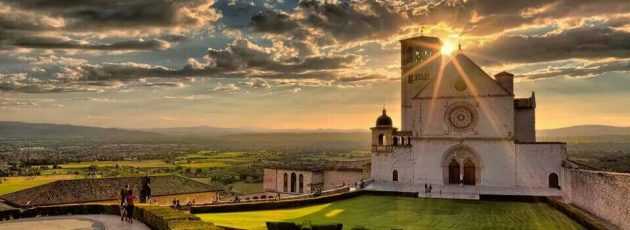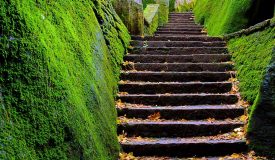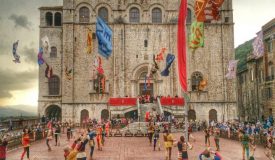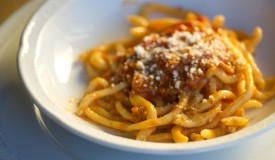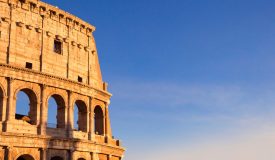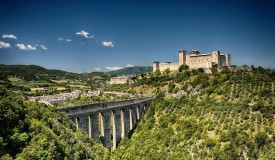“Italy in the footsteps of St.Francis” is a beautiful, 9 day itinerary, designed for curious travellers and pilgrims alike, who wish to visit Italy through some of the most important sites connected with the life of Italy’s Patron Saint.
Starting with 1 night in Rome, you will explore the Eternal City, where St. Francis went to meet the Pope to request permission to form his Order. We will then move on to Spoleto, Assisi and Gubbio in Umbria. You will also cross the border into Tuscany to visit Arezzo and La Verna, where the Saint received the stigmata.
On Day 7 of our Tour we will actually walk a leg (one of the most scenic of the entire path) of the famous “St.Francis’ Way” – a route stretching from La Verna down to Rome.
The tour will end with 2 nights in Rome. We will take a private Classic Tour of the city (including the Colosseum, Forum and the unmissable Sistine Chapel) and have some free time for shopping, before we say “arrivederci”…
On the “Italy in the footsteps of St.Francis” Tour you will:
- See the most important sites connected to the life of St.Francis;
- Spend 3 nights in the Eternal City;
- Visit the towns of Assisi, Spoleto, Gubbio in Umbria, plus Arezzo and La Verna in Tuscany.
Italy in the footsteps of St.Francis Itinerary
Italy in the footsteps of St.Francis Detailed Itinerary
Day 1 - Arrive in Rome: meet your fellow travel companions - Welcome Dinner
Upon arrival in Rome, you will be met and transferred to your elegant, centrally located hotel.
In the evening, the group will get together for a welcome dinner at a traditional Roman enoteca in the heart of the Eternal City.
Overnight in Rome.
Day 2 - Rome - In the footsteps of St.Francis of Assisi
Today, we will be visiting, amongst other treasures (Basilica of Santa Croce in Gerusalemme and tomb of St.Peter), the Basilica of St. John Lateran. The Cathedral of Rome and once the official residence of the papacy, is the highest ranking of all the churches in Rome, known as “Archbasilica” and as the oldest and most important basilica in the world, it holds the title of Ecumenical Mother Church of the Catholic Faith.
Constantine’s original basilica was built on the site of the barracks of the Imperial Guard, who had fought against him at the Battle of Ponte Milvio. Following his victory, Constantine disbanded the guard and razed the barracks, eventually donating the Lateran Palace to the Pope. Like the other basilicas, St. John’s has been rebuilt over the years, much of its current appearance dating to the 17th century, but the original private chapel of the pope, the Sancta Sanctorum, can still be seen across the road at the top of the Holy Steps.
Overnight in Rome.
Day 3 - Umbria - Spoleto: the conversion of St.Francis
The beautiful town of Spoleto is an unmissable stop for anyone wishing to learn about St.Francis’ life and message.
His biographer, Thomas of Celano writes: “…A little later, he saw in a vision a beautiful palace, and there he saw various suits of armour and a lovely bride. In that same dream Francis was called by name and was attracted by the promise of all these things. He therefore tried to go to Apulia in order to gain knighthood, and richly outfitted, he hastened to achieve the honours of knightly rank. The spirit of the flesh prompted him to give an interpretation of the flesh to the vision. In fact, in the treasury of God’s wisdom something even more magnificent was hidden there.
As he slept one night, someone spoke to him a second time in a vision and asked him with concern where he was going. He explained his plan and said he was going to Apulia to become a knight. The other questioned him anxiously: “Who can do more for you, the servant or the Lord?” “The Lord,” said Francis. “Then why do you seek the servant instead of the Lord?” Francis then asked: “Lord, what do you want me to do?” And the Lord said to him: “Go back to the land of your birth because I will fulfill your dream in a spiritual way.” He turned back without delay becoming even now a model of obedience.
These events took place as St.Francis was resting in the outskirts of Spoleto, by the ancient Basilica of S.Sabino, while on his journey to Apulia.
Furthermore, the Chapel of Relics in Spoleto’s Cathedral, houses the only autograph letter by St.Francis to be found outside Assisi’s Sacred Convent. We will also visit the Franciscan Convent founded by the Saint himself in 1218 on top of Monteluco.
Day 4 - Assisi - birthplace of St.Francis
After breakfast this morning, we’ll depart for a full day in Assisi, St.Francis’ birthplace. Here you will visit all main sites connected to the life of St.Francis, of course (Basilica, San Damiano, Hermitage and Porziuncola).
A very special lunch stop today at S.Biagio Monastery (Brewery and Farming Estate). The Monastery is on the route of the so called “Cavalcata di Satriano”, a re-enactment of St. Francis’ final return to Assisi. Every September, a group of knights on horse back, retrace the journey made by a critically ill St. Francis, from Nocera through Satriano and Pian della Pieve, in 1226.
According to Franciscan sources, the citizens of Assisi were made aware of the seriousness of the illness, and sent a formal delegation of knights to bring him back to his hometown.
Day 5 - Gubbio and Frasassi Caves
Gubbio is an ancient Umbrian town, well known for a famous legend: the legend of St.Francis and the wolf.
When the small village of Gubbio was being terrorized by a blood thirsty wolf, it was the franciscan friar who came to aid. St.Francis told the villagers that he would speak to the animal and headed up into the forest to find it. He set off with other people but the further they went into the dark forest, the fewer men accompanied him: they fled in fear of seeing this blood thirsty animal.
When St.Francis reached the wolf’s territory he called out to it; standing without fear, only love, it is said that the animal came and laid at the saint’s feet. The wolf knew it had done wrong, killing the farm animals and injuring the townspeople, but it was scared and hungry. St.Francis took the wolf back to the village. When the villagers saw it, they cowered in fear and ran to hide. It was only when the Saint of Assisi called them back, telling them they were safe, did they return.
He explained to them the wolf was hungry and had only taken the animals to feed itself. It was then decided that to protect their village and their domesticated animals, they merely needed to keep the wolf fed.
It was through looking at the problem from both sides and finding the cause of the problem that an agreeable solution was found.
Day 6 - La Verna and Arezzo
La Verna Sanctuary is located in the Tuscan Apennines.
In the summer of 1224, St. Francis withdrew on the mountain for his ordinary spiritual exercises and silence. During his stay, he asked God to be able to take part, from the very deep of his heart, to the Passion of Christ, mystery of both love and pain. The Lord paid attention to his words and appeared to him in the guise of a crucified seraph who gave him as a gift the seals of the Passion. Francesco turned into a visible and concrete image of Christ, not only in his heart, mind and soul, which already were, but even in his exterior body.
The Stigmata episode together with Francis’ lifestyle are the most precious things given to his friars at La Verna.
Afternoon in Arezzo.
Day 7 - A Walk along the Franciscan Way: Stroncone to Greccio
On Day 7 of our Tour, those who wish will be able to actually walk a leg (easy but very scenic) of the famous “St.Francis’ Way – a route that stretches from La Verna down to Rome.
Our destination is the Shrine of Greccio: known as the Franciscan Bethlehem, this is an imposing architectural compound which clings to the bare rock. The original core of the shrine is the Cappella del Presepio (Nativity Chapel), built in 1228, the year of Saint Francis’ canonisation. The chapel stands over the grotto where, on Christmas Eve 1223, Saint Francis, with the authorisation of the Pope and the help of Messer Giovanni Velita, Greccio’s ruler, re-enacted the birth of Jesus for the first time in the history of Christianity, thereby establishing the first nativity play. The chapel is a grotto excavated in the stone, with a semi-circular vault.
The bare stone where the Saint laid down the simulacrum of Jesus can be seen below the modern-style altar, while a fine fresco by the school of Giotto can be found on the wall at the back. Its two scenes represent the Nativity in Greccio and the Nativity in Bethlehem, with the Virgin Mary breastfeeding Jesus.
Later in the day we’ll also visit the Sanctuary of Fontecolombo. Located in a secluded area in a forest, on the slopes of the very lush Mount Rainiero, it is often referred to as the “Franciscan Sinai”, being the site chosen by Saint Francis to write the Regola (Rule) of the Franciscan Order. Everything is sacred here: the buildings, the pure spring waters and the forest itself , because it houses the Sacro Speco, that’s the Sacred Cavern where Saint Francis wrote the Rule.
Day 8 - Classic Rome: Colosseum, Forum and the Vatican (Sistine Chapel)
A final day in Rome to take in all its classic sights: Colosseum, Forum and of course the unmissable Sistine Chapel.
Day 9 - Time to say "arrivederci"...
After breakfast, transfer to the airport in time for your flight home or else, talk to us about a possible tour extension.
